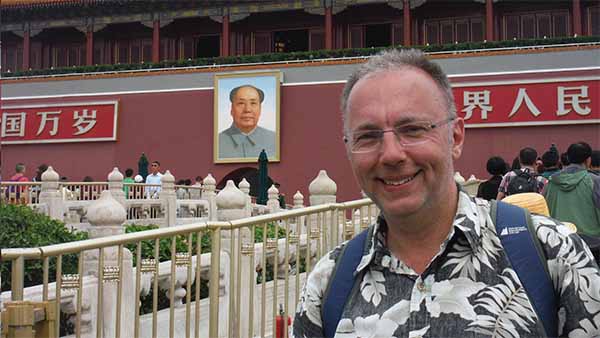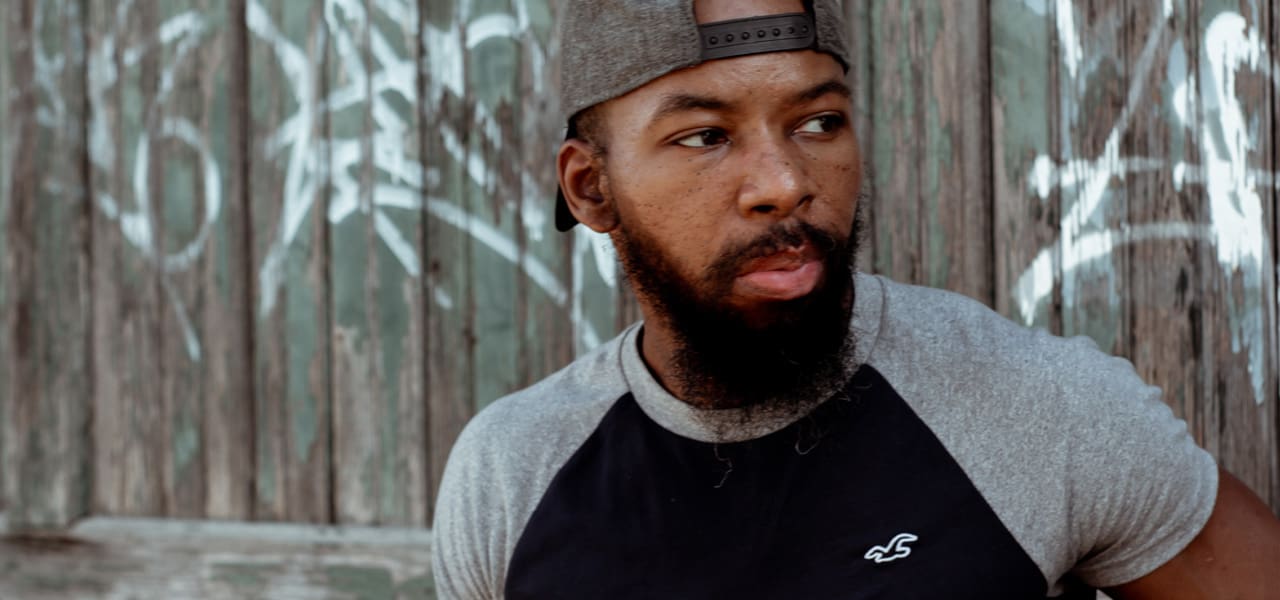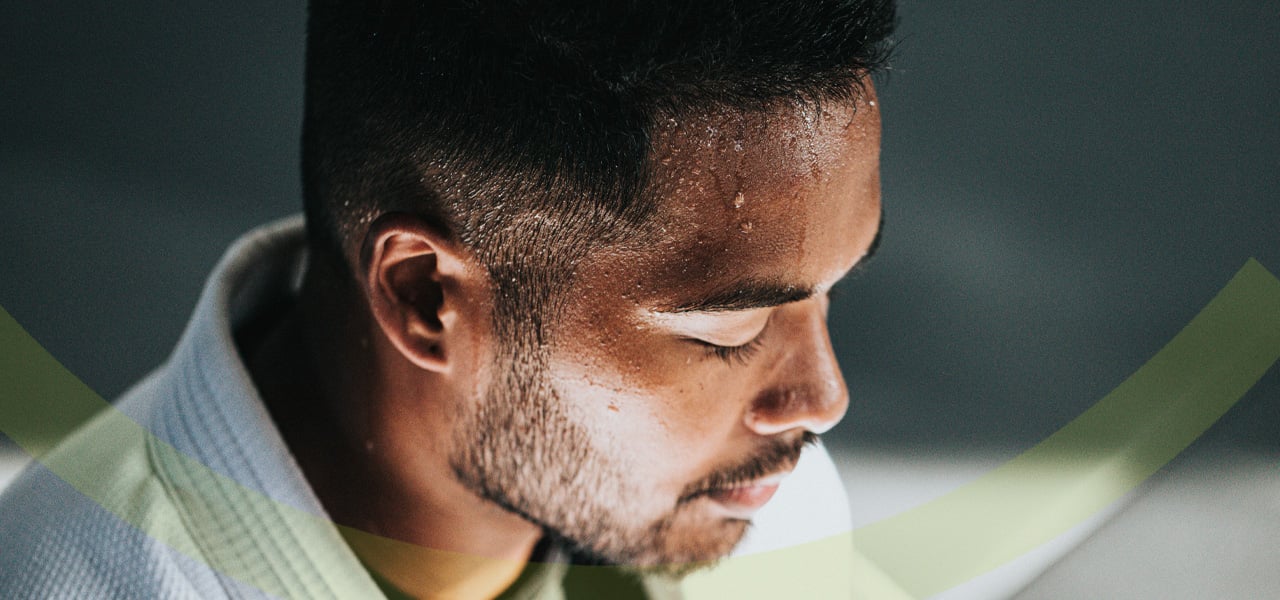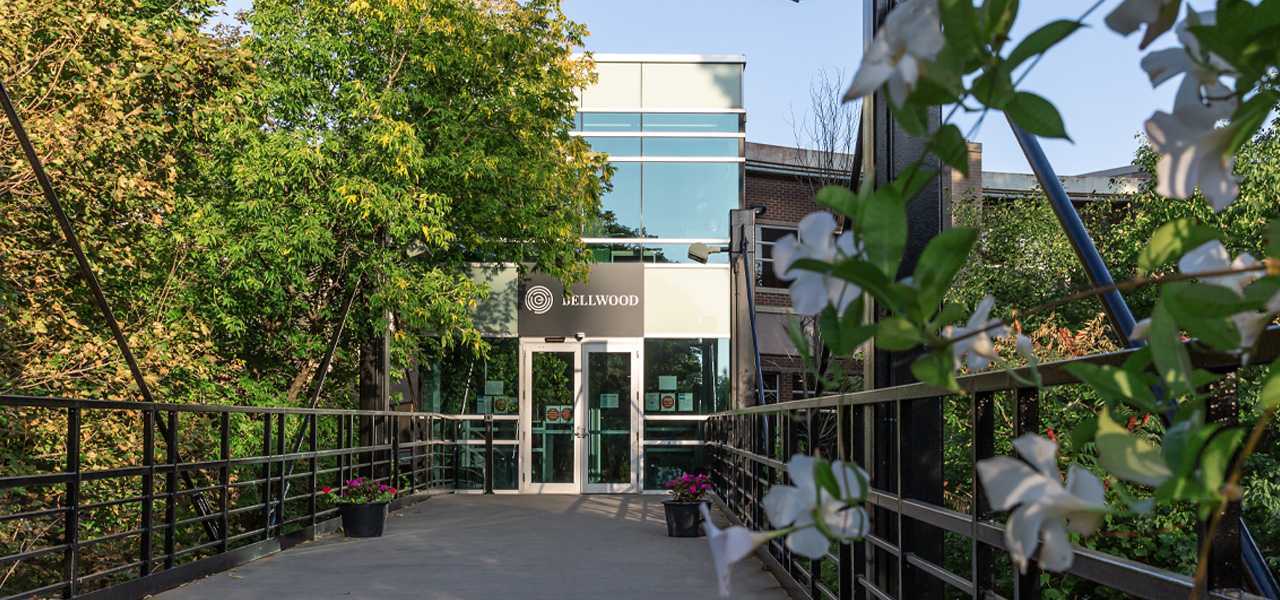By Jeremy Hainsworth
One sentiment I heard early on at Edgewood sticks in my head.
“Religious people fear hell; spiritual people have been there.”
It resonated with me. I have come to realize that hell exists between my ears – if I don’t live a spiritual life.
I bounced between extremes. On one hand, I was anxious about the future. On the other, I repeatedly tried to change the past, to fix mistakes, to change relationships gone wrong.
I was doing it all in my head and it was torture. So, to fix it, I increasingly numbed myself out.
Added to that was the sense – I remember it as far back as grade three – that I was somehow an outsider, that I did not belong. I was alone.
As for feelings and emotions, I didn’t seem to have any. It was as if I’d not received the full package of emotions as everyone else. I was cold, close relationships scarce.
The using began innocently enough – a few beers and joints with friends at 17. By 18, I was at university doing what students do. The drinking increased, smoking pot an almost-daily thing. Despite the fact I was more included in activities, if I was not the centre of attention I felt unwanted, unneeded.
Intimate relationships eluded me despite a growing circle of good friends, one of whom became my closest friend and using buddy for 35 years.
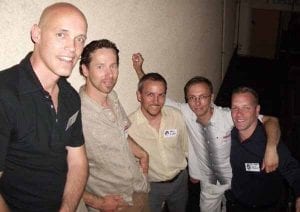
Jeremy, second from right, at a high school reunion.
At 20, I began working on a thesis, ironically about American Beat poet Allen Ginsberg. He was one of the Sixties proto-hippies, one of the psychedelic gurus. I told myself I could not be intellectually honest writing the paper if I didn’t try LSD. I loved it.
And, truth be told, I also enjoyed the elitism of the ivory tower, the “I’m better than” status I believed it bestowed on me.
The guy with whom I had fallen in love and I bought LSD on the steps of BC Supreme Court. That night, under Gustav Dore’s print of the famous tilting-at-windmills Don Quixote, my beau told me I was the devil.
The relationship was an exercise in futility, two people beset by demons. Yet, I returned to it again and again for 17 years with the same results. Agonizing frustration followed by angry exchanges.
I would spend the next 23 years tilting at the windmills of my mind, fogged in a cloud of alcohol, pot, LSD, MDA, MDMA, cocaine, crack cocaine and, finally, heroin.
As a teen in the late Seventies, my musical interests turned as I was introduced to the rebellion of punk. The speed of the music, its anger captured me. I was an avid concert-goer once I hit Vancouver. With that came alcohol and drugs, more and more alcohol and drugs.
I could not see it, but life was becoming unmanageable.
Most of my friends were graduating and pondering law school or well-paying jobs. I had a thesis that was late.
I took a job as a dishwasher and found an apartment in Vancouver’s West End. The restaurant staff was a ready-made party and I joined right in. The kitchen manager, a musician, introduced me to Vancouver’s underground scene. I fit right in with these misfits, spending my nights in smoke-filled bars filled with mohawked punks, music pounding, drink and drugs flowing freely. But, I was arrogant.
Some of the folks from that restaurant remain close friends today. Some are in recovery. They still joke about my aloofness, my intellectualizing.
My close friend had quit university and gone to work in a trendy clothing store. The social scenes of our workplaces dovetailed perfectly.
I remained obsessed with my beau, although the fights continued. I did not have the sense to walk away. I was repeatedly emotionally abused, and I allowed it. I thought it was normal. I clung to a fantasy for dear life and drank and drugged away my pain.
Under threat from my professor, I finished my thesis and graduated from UBC with honors.
I took off to Europe for four months, thinking I could escape the failed relationship and substance abuse. When I returned, I moved into a house with my beau, my best friend and others. It didn’t last.
I moved downtown with people from the restaurant. The party continued.
I applied to write the law school admissions test. I drank all the way through the prep course. I couldn’t stop. My score was not good.
In 1989, I entered journalism school, immediately gravitating to the hard drinkers. We rejected the old student party spot and fell in with the hard-drinking regulars at Vancouver’s press club. I thought this was normal.
Upon graduation, I took a job at a newspaper in Prince Rupert. I was shown my desk. As I cleaned it out, I found a bottle of vodka.
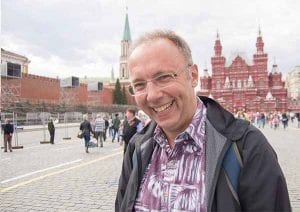
In Moscow’s Red Square outside the Kremlin.
“This is perfect,” I thought.
I was there two and a half years before I was promoted to run the daily paper in Dawson Creek. As I left Prince Rupert, one friend opined the bar owners would be distraught because their profits would fall with my departure.
In Dawson Creek, I showed up for work with hangovers at least twice a week. The publishers and I would head for the Legion Monday, Wednesday and Friday. Ironically, we called these drinking sessions meetings.
I was again promoted, this time to Vancouver, to become senior editor of the newspaper chain. I was presented with a framed front page of the newspaper. On the back, one staff member, who now has many years of sobriety, had written, “Strength, Courage, Wisdom.” It took me another nine years to understand what had been passed to me with that inscription.
After 18 months in Vancouver, I was sent east to help keep the Calgary Herald running during a strike. For the scabs, the company ran open bar tabs.
I volunteered to be a court reporter, opening the gates that would put psychological scars on top of psychological scars. Day after day, I listened to tales of man’s inhumanity against man. My belief was that I could somehow put the stories in a closed box in my brain and forget about them. I was wrong.
The situation began to go south, and as I worked with some of the worst and best co-workers I have ever endured, my using turned to crack cocaine. I first used it in a drunken blackout. I do not remember doing the crack. All I knew the next day was that I wanted more. And more. I spiraled downhill. I was fired.
Moving back to Vancouver, working part-time for Canada’s national news service and part-time freelancing, my drug use went from once a week to daily. By the end, everything else was secondary to using.
I used in the bathrooms of my office building. On the floors above were federal drug prosecutors. I carried drugs and paraphernalia through FBI checkpoints. I thought the rules did not apply to me. I was special. I continued down my path of covering brutal crimes.
I was now working for an international news service. I covered the gruesomeness of the Robert Pickton serial killer case. I sat through testimony of the bombed Air India 747 — the plane falling apart, jet engines slicing into the passenger compartment, people still alive plunging miles to slam into the hard Atlantic Ocean.
Again, I thought I could put those details in that box in my head and forget them. I could not.

Landing a piranha on the Amazon in the Brazilian jungle.
My head was filled with horror. I drank and used heavily to forget it. But it was all still there in the morning as I headed back to court for more.
As one Edgewood counselor said to me, “Addicts love chaos. You love chaos more than most addicts. Journalism is chaos. You chose the most chaotic form of it and then the most grim. Did you choose that or did your addict choose it?”
Mind blown. I was dumbfounded.
“What have I done?” I asked myself.
In July 2006, I met another addict and fell in love. He was wonderful, an artist with a love of abstracts, a passion for Van Gogh. That October, he vanished. Abandoned again, I thought.
Not so. He was in treatment and on restrictions.
At his first opportunity, he invited me for dinner. It was a trick. I went to my first Narcotics Anonymous meeting that night.
I read How It Works. I said the Serenity Prayer with my arm around his shoulder. And, for the first time, I said to other people, “Hi, I’m Jeremy. I’m an addict.”
My partner went in and out of the program and rehabs. Each time out, it was “just one more.”
On May 12, 2007, his “just one more” was the last one. He overdosed and died. It was the worst day of my life. A beautiful soul snuffed out. My heart shattered. A family devastated.
I went berserk. My using went through the roof. I drained my bank accounts. The people I used with became scarier. All I cared about was getting loaded.
Finally, my family said “enough.”
I was removed from Vancouver as I waited to get into Edgewood.
My mum asked me, “If you haven’t used drugs in two weeks, why do you need to go to treatment?”
In a moment of clarity, I responded, “The drugs aren’t the problem. I’m the problem.”
My journey into the unknown began.
I was terrified. I rebelled against Edgewood, tried to fix the program, bitched about unfair rules. Then came acceptance. I realized I could not do this on my own. I learned that surrender was needed.
I began to listen. I began to see and hear how the experience of others could benefit me, how my experience could benefit others.
I learned why “we” is the first word in Step One. What we can’t do alone, we can do together. I learned how to ask for help. I learned to express my feelings instead of going straight to anger when I wasn’t getting my way. And I learned a program of recovery I can practice every day. I still do not do it perfectly.
Life is not without its challenges. I have to live with people every day and it’s not easy. They don’t do what I want them to do. My best friend from UBC residence continued to use, refusing to get into recovery, despite his two closest friends being years clean and sober. He told me A.A. had stolen his friends. He died alone on April 2, 2016, surrounded by drugs.
It was left to me to tell our friends and arrange a memorial dinner. His family held no funeral. I did not use. I reached out for help.
Another close friend died of cancer in November 2016. I did not use. I reached out for help.
I sat on her bed in the hours before she died and held her hand. I made an amend. I thanked her for being a huge part of my life. I kissed her and told her I loved her.
So, what has all this given me?
I have regained the trust of my family and friends. Friends ask me to look after their most precious things – their children. That is trust. For the most part, I have peace and serenity in my head. There are no voices calling my name.
And, I live my dreams. I have crossed Asia on the Trans Siberian Railway from Beijing to St. Petersburg via Mongolia. I have been skydiving in New Zealand. I have fished for piranha in the Amazon. In Moscow, I made a point of going to see my first original Van Goghs on the anniversary of my partner’s death. A photo was taken of me with one of the paintings. I sent it to his mother.
So there it is – my experience. What does it tell me?
It tells me that I lived to use and used to live. It tells me that one is too many and a thousand never enough. It tells me that recovery one day at a time is the truth. That gives me strength.
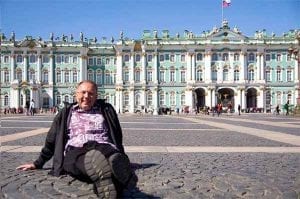
Life is good these days. Jeremy outside the Winter Palace of the tsars in St. Petersburg, Russia.
I accept that something in my head wants to kill me. To keep that at bay, I need to practice a program of recovery. That means telling the truth, if only to my sponsor so he can call bullshit when I need it most. It means doing the steps on a regular basis and going to meetings. I see others doing it and see it working in their lives. That gives me hope.
Yes, the monster still sits in my head waiting. If I ask for help and do the work, that monster is going to wait a long, long time. And, I’m OK with that.
